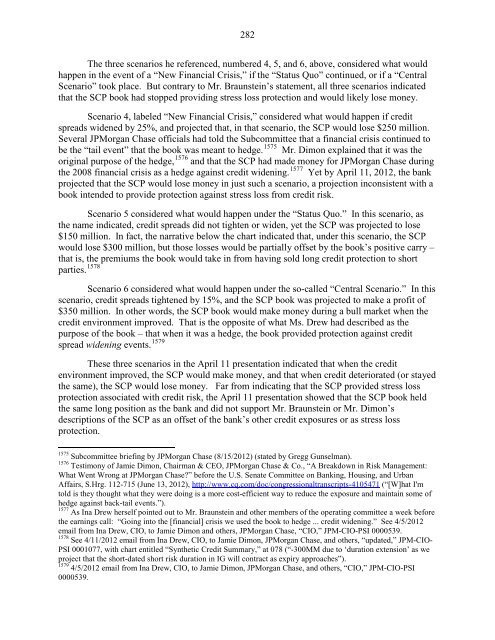JPMORGAN CHASE WHALE TRADES: A CASE HISTORY OF DERIVATIVES RISKS AND ABUSES
JPMORGAN CHASE WHALE TRADES: A CASE HISTORY OF DERIVATIVES RISKS AND ABUSES
JPMORGAN CHASE WHALE TRADES: A CASE HISTORY OF DERIVATIVES RISKS AND ABUSES
Create successful ePaper yourself
Turn your PDF publications into a flip-book with our unique Google optimized e-Paper software.
282<br />
The three scenarios he referenced, numbered 4, 5, and 6, above, considered what would<br />
happen in the event of a “New Financial Crisis,” if the “Status Quo” continued, or if a “Central<br />
Scenario” took place. But contrary to Mr. Braunstein’s statement, all three scenarios indicated<br />
that the SCP book had stopped providing stress loss protection and would likely lose money.<br />
Scenario 4, labeled “New Financial Crisis,” considered what would happen if credit<br />
spreads widened by 25%, and projected that, in that scenario, the SCP would lose $250 million.<br />
Several JPMorgan Chase officials had told the Subcommittee that a financial crisis continued to<br />
be the “tail event” that the book was meant to hedge. 1575 Mr. Dimon explained that it was the<br />
original purpose of the hedge, 1576 and that the SCP had made money for JPMorgan Chase during<br />
the 2008 financial crisis as a hedge against credit widening. 1577<br />
Yet by April 11, 2012, the bank<br />
projected that the SCP would lose money in just such a scenario, a projection inconsistent with a<br />
book intended to provide protection against stress loss from credit risk.<br />
Scenario 5 considered what would happen under the “Status Quo.” In this scenario, as<br />
the name indicated, credit spreads did not tighten or widen, yet the SCP was projected to lose<br />
$150 million. In fact, the narrative below the chart indicated that, under this scenario, the SCP<br />
would lose $300 million, but those losses would be partially offset by the book’s positive carry –<br />
that is, the premiums the book would take in from having sold long credit protection to short<br />
1578<br />
parties.<br />
Scenario 6 considered what would happen under the so-called “Central Scenario.” In this<br />
scenario, credit spreads tightened by 15%, and the SCP book was projected to make a profit of<br />
$350 million. In other words, the SCP book would make money during a bull market when the<br />
credit environment improved. That is the opposite of what Ms. Drew had described as the<br />
purpose of the book – that when it was a hedge, the book provided protection against credit<br />
1579<br />
spread widening events.<br />
These three scenarios in the April 11 presentation indicated that when the credit<br />
environment improved, the SCP would make money, and that when credit deteriorated (or stayed<br />
the same), the SCP would lose money. Far from indicating that the SCP provided stress loss<br />
protection associated with credit risk, the April 11 presentation showed that the SCP book held<br />
the same long position as the bank and did not support Mr. Braunstein or Mr. Dimon’s<br />
descriptions of the SCP as an offset of the bank’s other credit exposures or as stress loss<br />
protection.<br />
1575<br />
Subcommittee briefing by JPMorgan Chase (8/15/2012) (stated by Gregg Gunselman).<br />
1576<br />
Testimony of Jamie Dimon, Chairman & CEO, JPMorgan Chase & Co., “A Breakdown in Risk Management:<br />
What Went Wrong at JPMorgan Chase?” before the U.S. Senate Committee on Banking, Housing, and Urban<br />
Affairs, S.Hrg. 112-715 (June 13, 2012), http://www.cq.com/doc/congressionaltranscripts-4105471 (“[W]hat I'm<br />
told is they thought what they were doing is a more cost-efficient way to reduce the exposure and maintain some of<br />
hedge against back-tail events.”).<br />
1577<br />
As Ina Drew herself pointed out to Mr. Braunstein and other members of the operating committee a week before<br />
the earnings call: “Going into the [financial] crisis we used the book to hedge ... credit widening.” See 4/5/2012<br />
email from Ina Drew, CIO, to Jamie Dimon and others, JPMorgan Chase, “CIO,” JPM-CIO-PSI 0000539.<br />
1578<br />
See 4/11/2012 email from Ina Drew, CIO, to Jamie Dimon, JPMorgan Chase, and others, “updated,” JPM-CIO-<br />
PSI 0001077, with chart entitled “Synthetic Credit Summary,” at 078 (“-300MM due to ‘duration extension’ as we<br />
project that the short-dated short risk duration in IG will contract as expiry approaches”).<br />
1579<br />
4/5/2012 email from Ina Drew, CIO, to Jamie Dimon, JPMorgan Chase, and others, “CIO,” JPM-CIO-PSI<br />
0000539.



